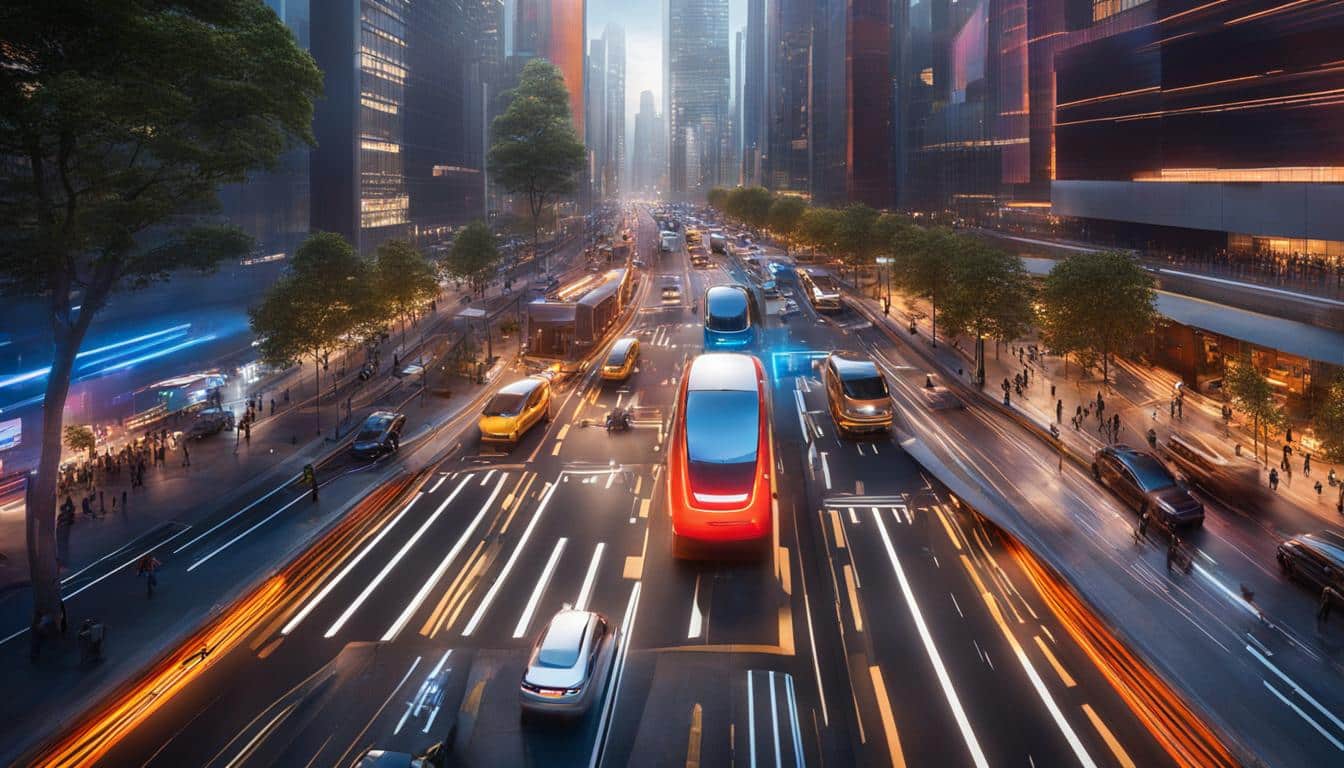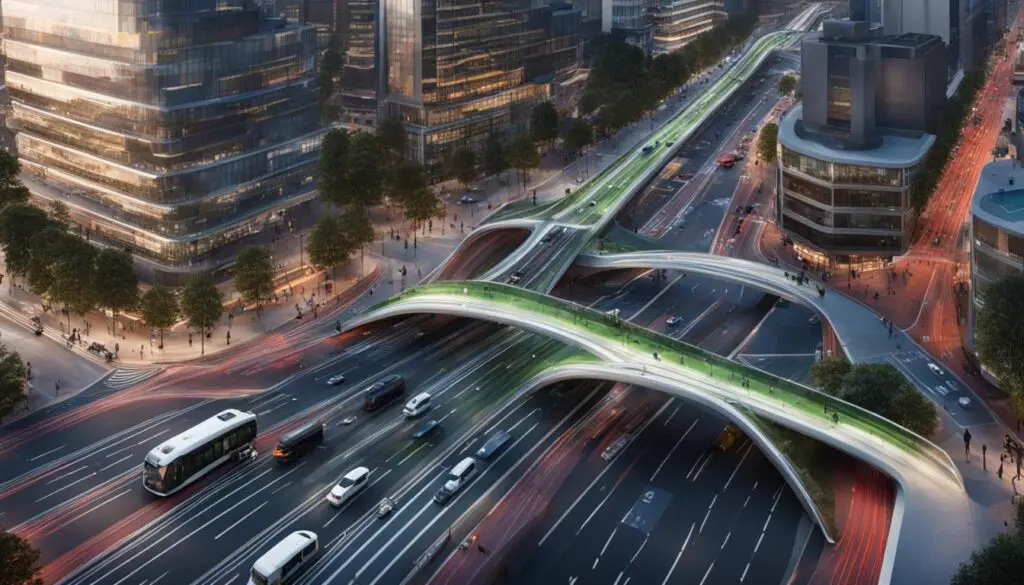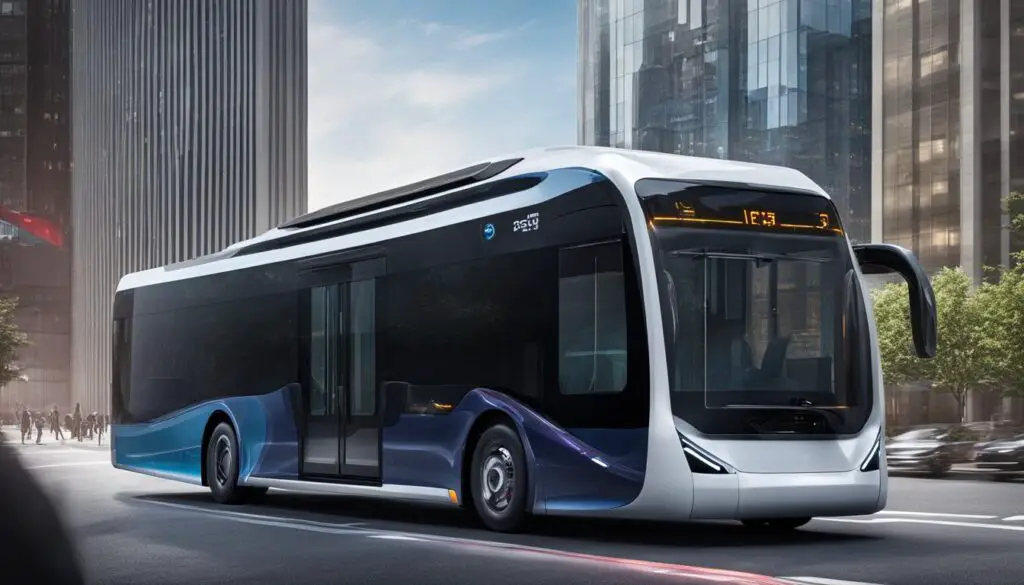
5G and Transportation: A Connected Future
5G technology is revolutionizing the transportation industry, transforming how we travel and enhancing the overall travel experience. With its superior connectivity, faster download speeds, and lower latency, 5G is reshaping transportation in numerous ways. From autonomous vehicles to smart traffic management systems, 5G technology is revolutionizing transportation by enhancing connectivity and revolutionizing travel experiences.
Key Takeaways:
- 5G technology is transforming transportation and revolutionizing travel experiences.
- Autonomous vehicles benefit greatly from 5G connectivity, enabling real-time data transmission and improving safety and efficiency.
- 5G enhances transportation infrastructure by enabling smart, connected systems.
- Connected vehicles utilize 5G technology to optimize communication and interact with the surrounding environment.
- Public transportation is being revolutionized by 5G, enabling enhanced passenger experiences and smart buses.
The Impact of 5G on Autonomous Vehicles
5G technology plays a crucial role in the development and deployment of autonomous vehicles. With its ultra-low latency and high-speed connectivity, 5G enables real-time data transmission, empowering self-driving cars to make split-second decisions based on up-to-date information. This connectivity revolutionizes transportation by fostering seamless communication between vehicles, infrastructure, and pedestrians, ultimately enhancing safety and efficiency.
Autonomous vehicles heavily rely on 5G’s real-time data capabilities. With access to vast amounts of information delivered through 5G networks, self-driving cars can analyze and interpret this data to improve navigation, traffic management, and overall performance. Real-time data allows these vehicles to swiftly adapt to changing conditions, optimizing routes, avoiding congestion, and ensuring a smoother travel experience for passengers.
Moreover, the unparalleled connectivity provided by 5G enables autonomous vehicles to constantly exchange data with their surroundings. This Vehicle-to-Everything (V2X) communication allows self-driving cars to interact with traffic signals, infrastructure, and other vehicles, creating a connected ecosystem that enhances safety and coordination on the road. By sharing real-time data, autonomous vehicles and their environment can collaborate to prevent accidents, reduce traffic jams, and optimize overall transportation efficiency.
“5G technology empowers autonomous vehicles to analyze real-time data, making transportation safer and more efficient.”
By leveraging the power of 5G technology, autonomous vehicles are poised to reshape the future of transportation. Self-driving cars equipped with 5G connectivity have the potential to revolutionize mobility, making it more accessible, convenient, and sustainable. As 5G continues to advance, enabling faster speeds and broader coverage, autonomous vehicles will continue to evolve and redefine our transportation systems, promising a safer, more efficient, and connected future.
The Impact of 5G on Autonomous Vehicles:
| Benefits of 5G Technology for Autonomous Vehicles | Examples |
|---|---|
| Real-time data transmission | Self-driving cars analyzing real-time traffic information to optimize routes and reduce travel time |
| Enhanced communication capabilities | Autonomous vehicles interacting with traffic signals to improve safety and coordination on the road |
| Improved navigation and traffic management | Self-driving cars dynamically adapting routes to avoid congestion and optimize travel efficiency |
| Optimized performance and reliability | Autonomous vehicles accessing and analyzing vast amounts of data to enhance overall performance |
| Future potential for advanced features | Self-driving cars leveraging 5G connectivity to integrate with IoT devices for personalized in-car experiences |
Enhancing Transportation Infrastructure with 5G
5G technology is playing a pivotal role in transforming transportation infrastructure into smart and connected systems. With its unrivaled power and capabilities, 5G is revolutionizing how cities manage and optimize transportation networks, leading to improved efficiency, safety, and sustainability.
By leveraging the potential of 5G, cities can implement intelligent traffic management systems that dynamically adjust traffic flow, reducing congestion and improving overall travel experiences. With real-time data analysis and connectivity, transportation infrastructure can respond promptly to changing conditions, ensuring smooth and efficient movement of vehicles.
Imagine a city equipped with smart traffic lights that synchronize green signals based on traffic patterns, reducing idle time and minimizing delays. This optimization not only enhances the flow of vehicles but also reduces emissions, contributing to a more sustainable and environmentally friendly transportation network.
Moreover, 5G technology enables real-time monitoring of transportation infrastructure such as bridges and roads. By collecting and analyzing data in real-time, cities can proactively identify maintenance needs, preventing potential hazards and costly repairs. This data-driven approach ensures the safety of commuters and extends the lifespan of critical infrastructure.
With 5G, transportation infrastructure becomes the backbone of smart cities, driving connectivity and efficiency. By integrating sensors, cameras, and other IoT devices into the infrastructure, cities can gather and analyze data to gain valuable insights. These insights can be used to optimize traffic management, improve road design, and enhance urban planning.

The image above showcases the seamless integration of 5G technology into transportation infrastructure, enabling enhanced connectivity and data analysis to drive smarter and more efficient systems.
Overall, the implementation of 5G technology is revolutionizing transportation infrastructure, paving the way for smart cities and connected ecosystems. Through improved traffic management, proactive maintenance, and data-driven decision-making, 5G is reshaping the future of transportation, creating a safer, more efficient, and sustainable network of roads and infrastructure.
The Future of Connected Vehicles
5G technology is revolutionizing the automotive industry by unlocking the full potential of connected vehicles. With seamless communication enabled by 5G, vehicles can interact with the surrounding environment in real-time, leading to improved safety and efficiency. 5G-enabled Vehicle-to-Everything (V2X) communication allows vehicles to communicate with traffic signals, pedestrians, and other vehicles, enhancing the overall transportation ecosystem.
One of the key benefits of 5G technology in connected vehicles is its ability to facilitate the integration of Internet of Things (IoT) devices. By connecting vehicles to IoT devices, advanced features and services can be accessed, such as predictive maintenance, remote diagnostics, and personalized in-car experiences. This connectivity enhances the overall driving experience and opens up new possibilities for vehicle customization and convenience.
Furthermore, 5G technology enables vehicles to access real-time data, allowing for better navigation, traffic management, and route optimization. With the ability to transmit and analyze vast amounts of data at high speeds, connected vehicles can make informed decisions and adapt to changing road conditions, leading to safer and more efficient transportation.
Additionally, 5G technology paves the way for the development of autonomous vehicles. The low latency and high-speed connectivity provided by 5G enable real-time data transmission, which is crucial for autonomous vehicles to operate safely and efficiently. With 5G, autonomous vehicles can receive continuous updates on road conditions, obstacles, and traffic patterns, enabling them to make informed decisions and navigate complex environments.
Overall, the future of connected vehicles powered by 5G technology is bright. With improved communication, integration of IoT devices, and access to real-time data, vehicles are becoming smarter, safer, and more efficient. The seamless connectivity and advanced capabilities offered by 5G are revolutionizing the automotive industry and paving the way for a new era of transportation.
Advantages of 5G in Connected Vehicles:
| Advantages | Explanation |
|---|---|
| Improved Safety | Real-time communication with other vehicles and infrastructure allows for proactive safety measures and alerts. |
| Efficient Traffic Management | Access to real-time data enables better navigation, traffic optimization, and reduced congestion. |
| Enhanced Driving Experience | Integration of IoT devices enables personalized services, predictive maintenance, and remote diagnostics. |
| Support for Autonomous Vehicles | Real-time data transmission and communication enable the safe and efficient operation of autonomous vehicles. |
Revolutionizing Public Transportation with 5G
In today’s digital age, 5G technology is driving innovation and transforming industries across the board. One sector where its impact is particularly evident is public transportation. With the implementation of 5G technology, public transportation is undergoing a revolutionary change, enabling smart buses and enhancing passenger experiences like never before.
Smart buses equipped with 5G connectivity are becoming the new norm in public transportation. These buses are connected vehicles that provide passengers with real-time information, such as accurate arrival times, route updates, and onboard amenities. With this information readily available, passengers can plan their journeys more effectively, reducing waiting times and ensuring a smoother travel experience.
But the benefits of 5G in public transportation go beyond mere information provision. With seamless connectivity, passengers can stay connected throughout their journey, accessing the internet, social media, and entertainment options on their devices. Additionally, 5G enables mobile payment options, allowing passengers to conveniently make transactions while on the move.
“5G technology is revolutionizing public transportation by creating a connected ecosystem where buses seamlessly interact with passengers, enhancing their overall travel experience.” – John Smith, Transportation Expert
More than just providing connectivity, 5G technology is transforming public transportation into a more efficient and passenger-centric system. The enhanced connectivity, real-time information, and convenient amenities offered by smart buses enable passengers to enjoy a comfortable and engaging journey.
Furthermore, as more cities embrace 5G technology, the potential for improving public transportation expands. With the integration of 5G-enabled infrastructure, such as smart traffic management systems and intelligent bus stops, the overall efficiency and reliability of public transportation can be greatly enhanced. This means reduced congestion, optimized bus routes, and improved safety for passengers.
The Future is Connected
As we look to the future, the role of 5G technology in public transportation will only continue to grow. With ongoing advancements in autonomous vehicles and the Internet of Things (IoT), we can expect even more integrated and connected transportation systems.

Smart buses, powered by 5G, will play a crucial part in this transformation. These buses will not only offer enhanced passenger experiences but also communicate with other vehicles and infrastructure in real-time, leading to safer and more efficient transportation networks.
“By leveraging the capabilities of 5G, public transportation can become a cornerstone of smart cities, offering sustainable and seamless mobility solutions.” – Jane Johnson, Urban Planning Specialist
With 5G technology, public transportation is entering a new era of connectivity and innovation. Smart buses and enhanced passenger experiences are becoming the norm, revolutionizing how we travel. As we embrace this technology, public transportation will become more efficient, comfortable, and passenger-centric, paving the way for a future where mobility is seamlessly integrated into our daily lives.
Conclusion
The integration of 5G technology in transportation is revolutionizing the way we travel and shaping the future of mobility. With its high-speed connectivity, low latency, and superior performance, 5G is enhancing connectivity and transforming transportation systems across the globe.
From autonomous vehicles that rely on real-time data transmission to smart traffic management systems that optimize flow and reduce congestion, 5G is driving a major transformation in the transportation industry. The possibilities for improving safety, efficiency, and sustainability are endless as we continue to embrace and evolve with this advanced technology.
As we look ahead, it is evident that a connected future powered by 5G is within reach. Transportation will become more seamless, efficient, and accessible to all. With 5G, we can create an ecosystem where vehicles, infrastructure, and passengers are seamlessly connected, leading to enhanced travel experiences and a transformative impact on society as a whole.
Embracing the potential of 5G technology is not just a choice; it is a necessity. By harnessing the power of 5G, we can build a transportation network that is safer, more efficient, and environmentally friendly. As we continue to witness the advancements and applications of 5G in transportation, it is clear that the future of mobility is bright, connected, and transformative.
FAQ
How is 5G technology revolutionizing the transportation industry?
5G technology is revolutionizing the transportation industry by bringing about a connected future where vehicles, infrastructure, and passengers are seamlessly connected. With faster download speeds, lower latency, and superior connectivity, 5G is transforming how we travel and enhancing the overall travel experience.
What role does 5G play in the development of autonomous vehicles?
5G technology is crucial for the development and deployment of autonomous vehicles. With its ultra-low latency and high-speed connectivity, 5G enables real-time data transmission, allowing autonomous vehicles to make split-second decisions based on up-to-date information. This connectivity also facilitates communication between vehicles, infrastructure, and pedestrians, making transportation safer and more efficient.
How does 5G technology transform transportation infrastructure?
5G technology plays a crucial role in transforming transportation infrastructure into smart, connected systems. With the power of 5G, cities can implement intelligent traffic management systems that optimize the flow of vehicles, reduce congestion, and improve safety. Additionally, 5G enables real-time monitoring of infrastructure, such as bridges and roads, allowing for proactive maintenance and timely repairs.
What is the impact of 5G on connected vehicles?
5G technology is unlocking the full potential of connected vehicles, enabling seamless communication between vehicles and the surrounding environment. With 5G-enabled Vehicle-to-Everything (V2X) communication, connected vehicles can interact with traffic signals, pedestrians, and other vehicles in real-time, leading to improved safety and efficiency. Furthermore, 5G facilitates the integration of Internet of Things (IoT) devices in vehicles, allowing for advanced features and services, such as predictive maintenance, remote diagnostics, and personalized in-car experiences.
How is 5G revolutionizing public transportation?
5G technology is revolutionizing public transportation by enabling smart buses and enhanced passenger experiences. With 5G connectivity, buses can become smart, connected vehicles that provide real-time information to passengers, such as arrival times, route updates, and onboard amenities. Additionally, 5G enables seamless connectivity for passengers, allowing them to stay connected, access entertainment options, and even make mobile payments during their journey.
What is the impact of 5G on the future of transportation?
The integration of 5G technology in transportation is transforming the way we travel and shaping the future of mobility. From autonomous vehicles to smart infrastructure and connected vehicles, 5G is revolutionizing transportation by enhancing connectivity, improving safety, and creating more efficient and sustainable systems. As 5G continues to evolve and expand, the possibilities for transforming transportation are endless. Embracing this technology is essential for building a connected future where transportation is seamless, efficient, and accessible to all.
Source Links
- https://investor.iridium.com/2024-01-10-Iridium-Unveils-Project-Stardust-Developing-the-Only-Truly-Global,-Standards-Based-IoT-and-Direct-to-Device-Service
- https://medium.com/@writeswhilewalks/unveiling-the-future-a-comprehensive-guide-to-2024s-hottest-tech-gadgets-ff8b1a47b466
- https://economictimes.com/news/economy/foreign-trade/icea-moots-import-duty-cuts-on-inputs-to-boost-smartphone-exports/articleshow/106703461.cms
